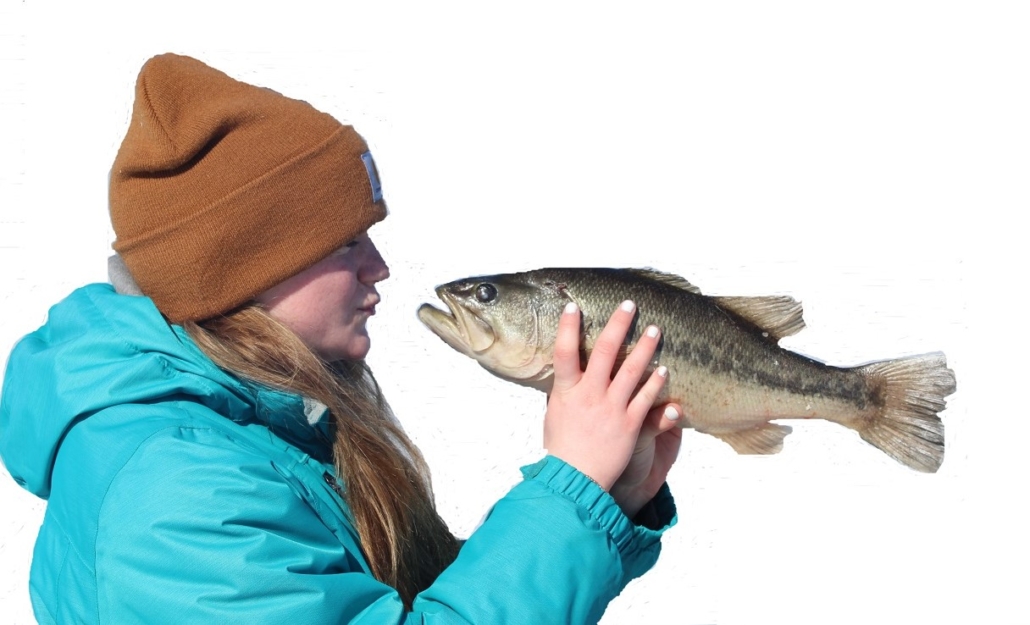
Sheldon, a local angler, puckers up to one of the fish she caught at the derby. (photo by Cindy Senkbeil)
Record number take part in ice fishing derby
On February 20, the China Four Seasons Club and the China Village Fire Department held its 3rd Annual Ice Fishing Derby. With over 500 estimated participants, this looked to be the most successful derby yet.
“The turnout was amazing again this year,” said Tom Rumpf, China Four Season’s President, and Chairman for the Ice Fishing Derby. “The weather earlier in the week had us a little concerned but the dip in temperatures made sure that China Lake had plenty of ice for safe fishing.
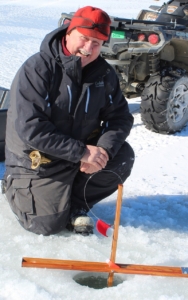
Don Doyon checks his fishing trap during the China Lake Ice Fishing Derby. Later in the day, Doyon won third place for his 2.96-pound smallmouth bass, while another family member, Ashely Doyon won first place with her 3.36-pound catch in the same category. (photo by Cindy Senkbeil)
Rumpf had sent his son Colby out on the lake throughout the day on Saturday to drill and test various spots. “The shortest depth he got was 17 inches, so we were confident with the thickness of the ice.” Anglers were still advised to used caution as they headed out onto the lake, some as early as 5 a.m., to secure a spot for fishing.
The camaraderie of the sense of community was strong out on the lake. Everywhere you went, people were setting up traps, barbequing, serving hot drinks, saying hello to fishing neighbors and friends. Each time a flag would go up on a fishing trap, surrounding groups would call out “Flag Flaaaag!” followed by laughing and people trying to figure out which lucky person had a fish on the end of their line.
“The fish were coming in all day to be weighed,” said Darrell Wentworth, China Four Season’s Vice President, and Derby committee member. “It was great to see so many kids coming in to weigh their fish, too. They were excited. It was great to see so many families involved.”
Central Church was set up on the ice again this year, helping kids who were new to the sport, learn about the fishing equipment, how to set up the traps, and what types of bait to use. Traps for Kids donated 25 ice fishing traps and the Derby Committee allowed Central Church to distribute them to the new anglers. In addition, Bar Harbor Bank & Trust along with Jack Traps of Maine supplied 75 bait buckets that kids received on a first-come basis. The Maine Audubon Society and Standard Waterproofing supplied goodies inside the buckets for the kids to enjoy.
The Derby Committee set up a children’s fishing category again this year, with prizes being awarded for the most perch by count. “We didn’t expect it, but this year we had a tie for fifth place,” said Rumpf. “We also didn’t expect so many kids to be in the other categories. One little girl (Madalynn Bellfleur) won first place for her 1.02-pound brook trout. I’m not sure who was more proud– her or her father. It was really great to see.”
“We were so fortunate and grateful for the amount of support we received from the community for the Ice Fishing Derby,” Rumpf continued. “We had over $7,000 worth of donations in the form of fishing prize money and door prizes to give away. Every single one of those dollars went back to the derby participants. We had over 50 door prizes! I had people contacting me two days before the event asking how they could help. It was just amazing.”
The top fishing prize, also known as the “Lunker of the Day” went to Lukas Finely for his largemouth bass that weighed in at 5.36 pounds. Last year’s Lunker was a 6.60 pounder caught by Jeremy Ross. The derby finished off with a fireworks display performed by Central Maine Pyrotechnics. A full list of fishing winners as well as door prize winners can be found on the derby website: chinalakeicefishingderby.com.
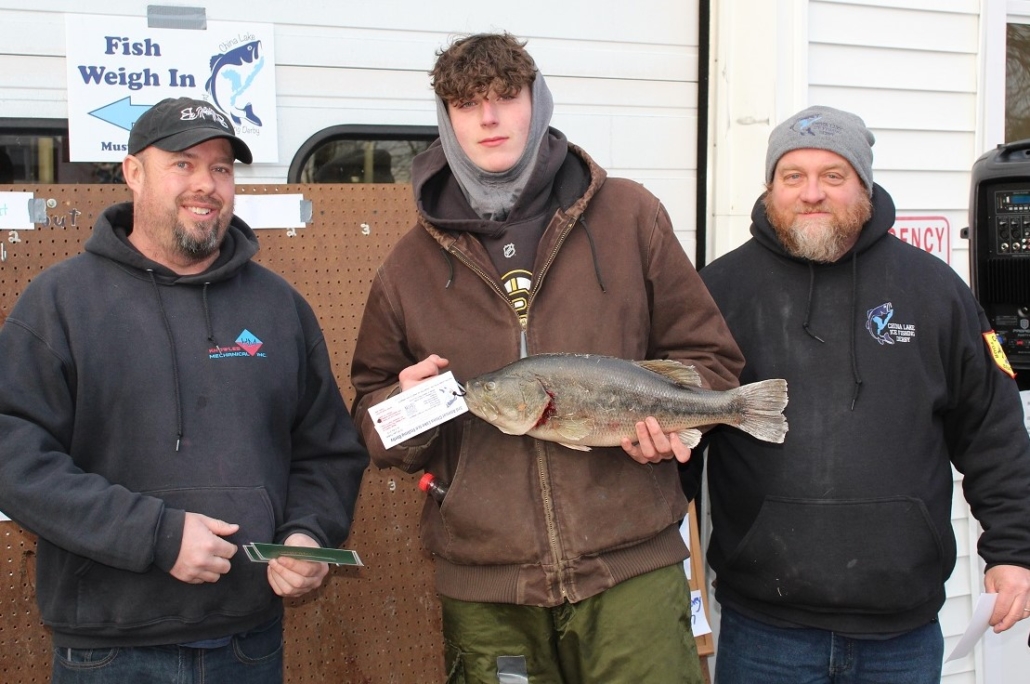
Matt Allen (right), owner of Bugbusterzzz Pest Control, sponsored the largemouth bass category and presented the first place prize to Lukas Finely for his 5.36-pound catch. Tom Rumpf (left) announced that Lukas’ fish also was the Lunker of the Day – the largest fish caught during the China Lake Ice Fishing Derby, held on February 20, 2022. (photo by Cindy Senkbeil)
3rd Annual China Lake Ice Fishing Derby WINNERS!
LUNKER OF THE DAY! $200 – Maritime Farm – Lukas Finely – Large Mouth Bass – 5.36 lbs.
Brook Trout
1st place $150 – Vassalboro Car Care – Madalynn Bellfleur – 1.02 lbs.
2nd place $75 – AMP Electric – Kaila Bourgeois – .88 lbs.
3rd place $25 – KC Auto – Sheldon – .70 lbs.
Brown Trout
1st place $200 – Central Maine Auto Group – Trevor Brockway – 3.44 lbs.
2nd place $100 – New England Import – Ava Smith – 3.26 lbs.
3rd place $50 – Greg’s Restaurant – Cameron Bragg – 2.46 lbs.
Large Mouth Bass
1st place $100 – Bug Busterzzz – Lukas Finely – 5.36 lbs.
2nd place $50 – Bug Busterzzz – Brandon Farrin – 5.08 lbs.
3rd place $25 – Bug Busterzzz – Ben Frazer – 4.96 lbs.
Pickerel
1st place $100 – China Variety & Redemption – Dakota Champagne – 3.96 lbs.
2nd place $50 – Adam’s Realty – Tristian Anderson – 3.78 lbs.
3rd place $25 – Greg’s Place Restaurant – Sawyer Bragg – 3.70 lbs.
Small Mouth Bass
1st place $100 – Central Machine – Ashley Doyon – 3.36 lbs.
2nd place $50 – Fernald Family Chiropractic – Jess Mullen – 3.26 lbs.
3rd place $25 – Bob’s Glass and More – Don Doyon – 2.96 lbs.
Children – 15 and under
Perch: White/Yellow – Most by Count
1st place $50 – KC Auto – Madisyn Niles with 30!
2nd place $40 – North Country Harley Davidson – Isaac Gigvere with 13.
3rd place $30 – North Country Harley Davidson – Nick Bowman with 7.
4th place $20 – North Country Harley Davidson – Ellie Soule with 4.
Tie for 5th place $10 – North Country Harley Davidson – Brook Shorey with 2.
Tie for 5th place $10 – Sandra Isaac Images – Shelbie & Haley with 2.
Honorable Mention – Chase Richardson with 1.
Door Prizes Winners’ List:
Barefoot Custom Coating – $400 Gift Certificate – Scott Braley.
AFC – Augusta Fuel Co. – 100 Gallons of Fuel – Joel Fernald.
Brookfield Renewable Energy and Jack Traps of Maine -Lithium StrikeMaster Auger – Zach Needham.
Jack Traps of Maine – (3) Jack Traps – Roberta Dionne, Jared Grenier & Ziggy.
Kim Mackenzie for Edward Jones – Clam 360 Portable Ice Shack – Nichole Bilodeau.
Standard Waterproofing – Jet Sled and a Hand Auger – Sadie Marte.
MA Haskell – $250 Gift Certificate – Tim Theriault.
Maine Ice Shack Rentals – 8×10 Ice Shack and Gear Rental – Herbie Shores.
North County Rivers – Rafting Trip for (2) – Nathaniel Rickman.
B&B Septic – $250 Gift Certificate for Service – Wayne Dubay.
Whitt’s Garment Works – (2) Sweatshirt and Hat – Elijah Gigvere & Norm Parker.
Whitt’s Garment Works – (2) Coat and Hat – Bill Cook & Rick Dumont.
Magic Falls Rafting Company – Rafting Trip For 1 – Jeanne Marquis.
Heritage Traps – (3) Red Heritage Laker Tip-Ups – Kevin Shores (+t-shirt), Wayne Dubey & Kraig Violett.
Lakeview Lumber – (2) $50 Gift Certificate + Extras! – Scott Braley & Ben Loubier.
Central Maine Power Sports (2) $50 Gift Cert. – Peter Quigley & Ron Knowles III.
Outback Beauty – (2) Jack Traps – Skeet Smith & Brittney St. Armond.
GHM Insurance Agency – (2) $50 Gift Certificates to MMCC – Jerry Keay & Katherine Wight.
Knowles Mechanical – $100 cash – Pauline Rancourt.
MJEK Seafood- (2) $50 Gift Certificate – Doug Hillman & Gary McCarthy.
Hannaford Supermarkets – $50 Gift Certificate – Gene Cowing.
Fish Tails Emporium – $50 Gift Certificate – Floyd Harkins.
Tobey’s Grocery – $50 Gift Certificate – Darrell Wentworth.
Raider’s Sugarhouse – Maple Products Gift Basket – Bill Reed.
Silver Street Tavern – (2) $25 Gift Certificates – Nate Pelletier & Elijah Crockett I.
Polished Salon – (2) $25 Gift Certificates – Dan Brockway & Jack Flanagan.
Korner Store – (2) $25 Gift Certificates – Priscilla Adams & Ryan Newgard.
Irving’s Circle K – (2) $25 Gift Certificates – Sara M & Stephen Labbe.
Hussey’s General Store $40 Gift Certificate – Morgan Britto.
Savage Nutrition – (2) $20 Gift Certificate – Barb Frost & Jody Ray.
Bolley’s Famous Franks- $30 Gift Certificate and a T-Shirt – Eric Lind.
Fred’s Coffee – Coffee Gift Basket – Robert Folson.
Rita’s House of Pizza – $25 Gift Certificate – Jared Grenier.
Asian Cafe – $20 Gift Certificate – Robert Folson.
Barber Parlor – Free Hair Cut – Henry Carter.
Special THANK YOU to Bar Harbor Bank & Trust, Traps for Kids, Maine Audubon Society, Standard Waterproofing, and Jack Traps of Maine for donating the Kid’s Bait Buckets and all the goodies that went inside! The kids loved them!! Next year we hope to give away 100 of them!!
THANK YOU to Central Church for setting up and helping teach kids how to ice fish and introducing them to this lifelong sport.
THANK YOU to Casella Waste Systems for taking care of our essential needs.
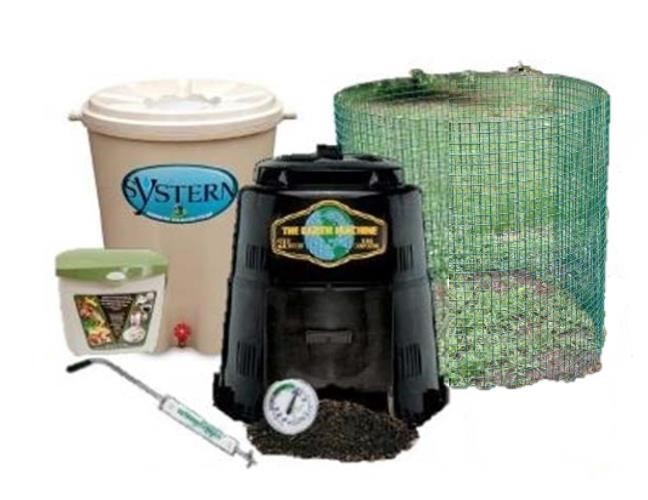



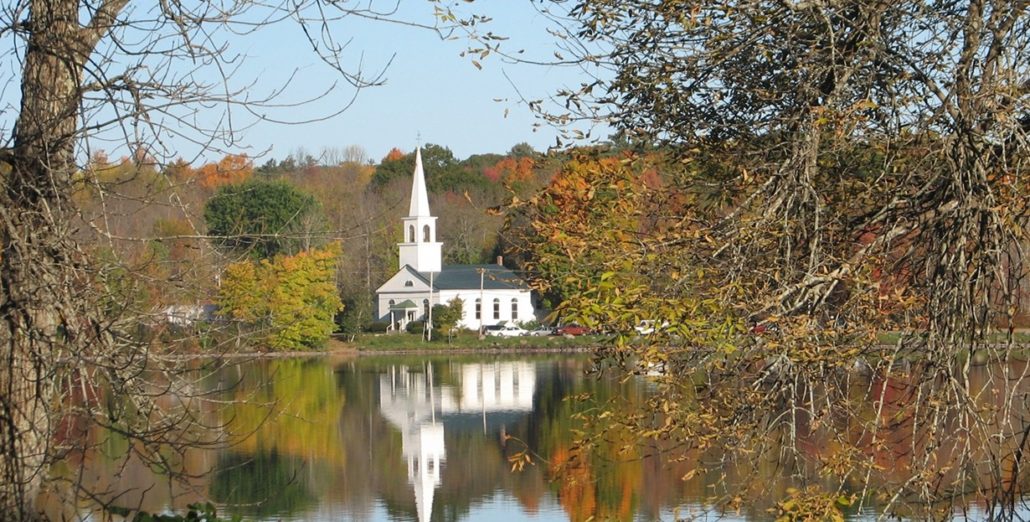





 Pike
Pike
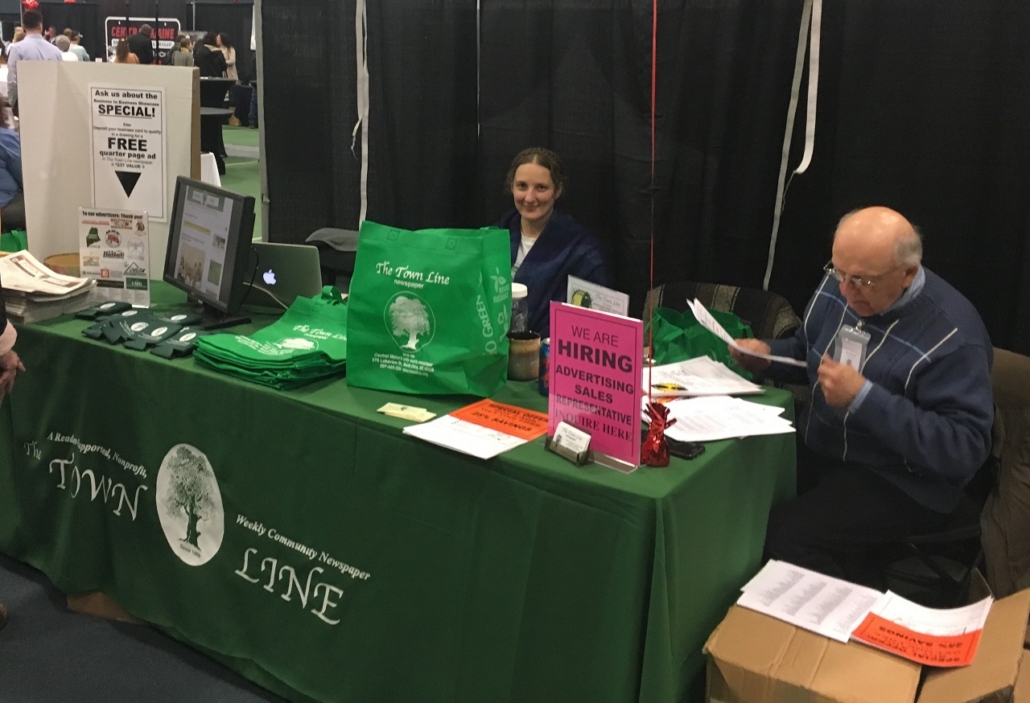
 The General Federation of Women’s Clubs (GFWC) Semper Fidelis Club is off to a great start in 2022! Belonging to an international women’s organization dedicated to community improvement by enhancing the lives of others through volunteer service, members are engaged to working with the community.
The General Federation of Women’s Clubs (GFWC) Semper Fidelis Club is off to a great start in 2022! Belonging to an international women’s organization dedicated to community improvement by enhancing the lives of others through volunteer service, members are engaged to working with the community.